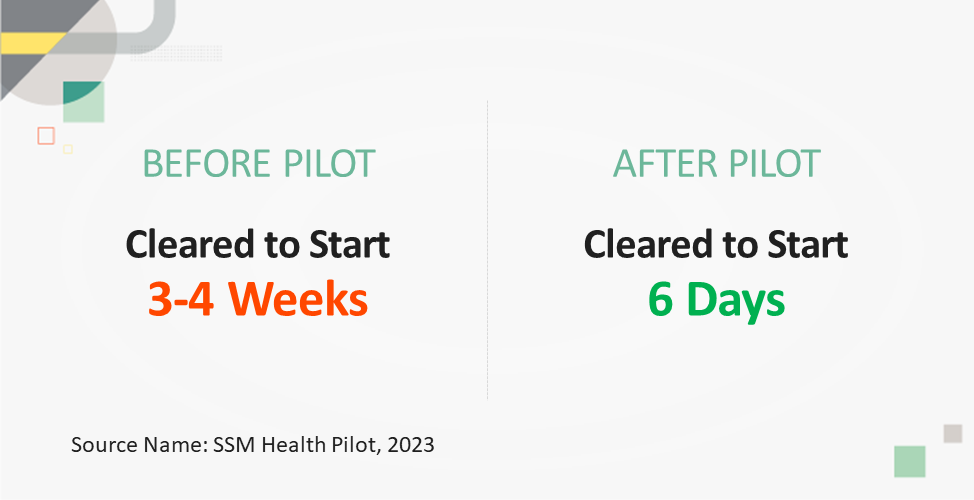January 10th, 2024 | Sterling
3 Proven Strategies to Attract and Onboard Critical Healthcare Talent

Sterling’s healthcare team recently attended one of our most anticipated events: LEAP TA Healthcare. We enjoyed networking with Talent Acquisition (TA) leaders from some of the largest health systems in the US and hearing about their strategies and success stories attracting critical frontline workers. Our team also had the opportunity to share how we helped our client, SSM Health, reduce the time between their candidates accepting offers to starting work by outsourcing their initial drug and health screening services.
What can your organization do to build a stronger TA team and attract top healthcare talent? How should TA leaders rethink their onboarding process so candidates can get started faster? Let’s explore 3 proven ways the healthcare industry can effectively attract and onboard critical positions, based on what Sterling’s healthcare team learned at LEAP TA Healthcare.
#1: Build an Internal Staffing Agency
Health systems have relied on staffing agencies to alleviate the shortage of qualified personnel and to reduce the time and resources required to fill such positions. However, as Covid-19 surged, so did the costs: by the end of 2022, contract labor expenses were 500% higher than they were before the pandemic. Although travel nursing salaries have started to plateau, organizations are still seeking ways to reduce costs and improve operations.
At LEAP TA, many TA leaders shared their journey spent building and implementing their own internal staffing program. One non-profit healthcare system discussed their story of how their internal contingent labor workforce, specifically for nurses, enabled them to offer flexible options to travel and stop/start work while also cutting costs. Here are some of the approaches and outcomes of this program:
- They developed an internal team specific to nurses that managed the temp and PRN talent pool and which also assigned nurses to their appropriate assignments.
- They focused on hiring RNs as their recruiters. They believed they needed recruiters who can “walk their talk” with other RNs.
- The organization’s pay rate was 30% cheaper than their agency costs, but still above their “normal wages” for internal temps with 13-week assignments.
- Since launch, they’ve saved $55M in cost savings. This has enabled them to put more money into conferences, paid ads, and their virtual recruitment platform.
#2: Outsource Drug & Health Screening Services
Although hospitals and other health systems typically have their own pre-employment drug & health screening program, the array of challenges and stress that can come with this important step are often felt between both the employer and their candidates. Candidates can miss their appointments and delay their onboarding, the drug test site could take weeks to deliver results, and tracking down clinical results is often manual and time-consuming.
SSM Health, a Catholic, not-for-profit health system with over 40,000 team members and more than 12,800 providers, was looking for a way to attract, onboard, and retain their nurses at a faster rate while also improving engagement. Sterling and SSM Health led a session on how they were able to reduce the time it took to clear their candidates’ start to work time from 3-4 weeks to 6 days:
- SSM Health launched a pilot project in St. Louis that focused on onboarding 300+ nurses.
- They created specialization within their recruiting and preboarding teams by having dedicated nurse recruiters and nurse pre-boarding specialists and by developing custom talk tracks and candidate outreach specific to nurses.
- They used Sterling’s Clinical Concierge to outsource their drug and health screening services, enabling nurses to complete all their lab-based services at a location most convenient to them. They would typically receive results of their lab-based services at the same time as the background check, while Sterling’s dedicated Clinical Concierge team handled any discrepancies and cases involved in these services.
- They also improved their reporting capabilities with Sterling that showed real-time visibility into each of their individual candidates, offering weekly recaps and program level details, and proactive analysis and recommendations.

#3: Partner with Communities Locally and Nationally
“We are losing nurses as fast as we are hiring them.”
A TA director told us this during LEAP TA Healthcare, and it really stuck with us. Just like other health systems, one hospital in Florida struggled to find nurses during Covid-19 and continued to face this challenge post-pandemic. They knew they needed to rethink their recruiting strategies beyond virtual job fairs and “posting and praying.” This prompted them to explore community partnerships and to recruit earlier:
- To build more pipeline with nursing students, they identified schools their nurse graduates came from that also had a strong nursing program and developed Ambassador programs.
- They started building more partnerships not just with local schools, but with community partners and universities nationwide who had strong networks within their community. This networking allowed the hospital to spread the word about their brand.
- They also started attending and exhibiting at nursing conferences nationally, engaging with the nurses attending the conference, and following up with them afterwards about career opportunities.
Due to all of this increased activity, they saw a decrease in job openings by 60%, which significantly impacted their vacancy rates and helped with nurse retention.
Rethink Your Recruitment Process
As TA teams continue to navigate today’s challenging landscape, we areSterling is optimistic in the creative approaches health systems have taken to meet their growing workforce needs. To succeed, these teams must innovate by fostering partnerships with educational institutions and communities, leveraging technologyto automate processes and streamline tasks involved in hiring, and embracing a diverse and inclusive workplace.
Discover how Sterling’s healthcare background checks and other solutions can help you attract and onboard critical talent.
Sterling is not a law firm. This publication is for informational purposes only and nothing contained in it should be construed as legal advice. We expressly disclaim any warranty or responsibility for damages arising out this information. We encourage you to consult with legal counsel regarding your specific needs. We do not undertake any duty to update previously posted materials.

